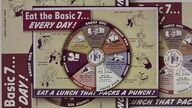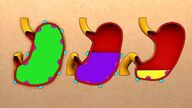In fact, we all know the fact that if we eat only meat and not rice, vegetables and fruits every day, it is inevitable; but if we only eat rice, vegetables and fruits and not meat, there is no problem. Scientists believe that the diet of any animal must be adapted to its physiological structure. Human's physiological structure, bodily functions and digestive system are completely different from those of carnivores, and human's physiological structure is not suitable for eating meat. Mammals can be roughly divided into carnivores, herbivores and leaf-eating animals and fruit-eating animals according to their eating habits.
1. Carnivores
All carnivores, including lions, dogs, wolves, cats, etc., have many common characteristics, which are obviously different from other animals. They all have a very "short" digestive system. The length of the small intestine of carnivores is only about three times the length of the body (the trunk, excluding the head and limbs). This is because meat food decays extremely fast. If it stays in the body for too long, the poison generated by the decay will be immersed in the bloodstream. Therefore, carnivores have formed a shorter digestive tract through long-term evolution, so that the corrupted meat and the poisons produced by it can be quickly excreted from the body. In addition, the stomachs of carnivores also contain higher concentrations of hydrochloric acid to digest the fibrous tissue and bones in the meat. The strength of hydrochloric acid is about 20 times stronger than that of vegetarian animals.
Carnivores often go out to hunt in the shade at night, and sleep during the day. Therefore, it is not necessary to sweat through the sweat glands of the skin to lower body temperature, but to dissipate heat through perspiration through the tongue. Veggie animals are different. Animals such as cows, horses, and deer spend most of the time foraging under the scorching sun from morning to night. Therefore, it is necessary to sweat a lot through the sweat glands of the skin to lower the body temperature.
The biggest difference between carnivores and vegetarian animals is the difference in teeth. In order to hunt prey, carnivores need sharp claws, strong jaws, and long, sharp incisors and canine teeth (in the front of the mouth) to pierce and tear (mainly relying on teeth) tough flesh. Vegetarian animals generally chew grains and other foods in their mouths for preliminary digestion, and then feed them into the stomach, while carnivores do not have flat molars, so meat is a concentrated food and does not need to be chewed in advance. , The digestion process is almost all carried out in the stomach and intestines.
Take a cat as an example. It can hardly chew food with its teeth.
2. Herbivores
Such animals generally live by eating herbs, branches and leaves of trees or other plants, such as elephants, cattle, sheep, and camels. All they eat are rough or hard foods. The saliva of herbivorous animals generally contains a digestive fluid called salivary amyloid, which is used to digest starchy foods. The digestion process has already begun in the mouth. Those rough foods must first be chewed and mixed with salivary amylase before they can be sent to the intestines and stomach for further decomposition. Therefore, herbivores have 24 flat molars, which can chew food by slightly moving left and right (the teeth of carnivores can only move up and down). Herbivores have no claws and have no pointed teeth. When they drink water, they use their mouths, while carnivores use their tongues. Unlike carnivores, the plant foods eaten by herbivores will not rot quickly, and can be fully digested and absorbed through the intestine slowly, so their small intestine is much longer than carnivores, about 10 times the body length .
3. Fruit-eating animals
Such animals mainly include great apes, an ancestor of the animal kingdom closest to humans. Great apes mainly live by eating fruits and nuts. They have flat molars for chewing food; their saliva is alkaline, and the same as herbivores also contain salivary amyloid, which is used for the initial digestion of food in the mouth; their intestines are surrounded by twists and turns, and their intestines The length is about 12 times the length of the body (trunk), suitable for slowly digesting fruits and vegetables.
4. Humanity
The physiological characteristics of human beings are almost identical to those of fruit-eating animals, very similar to herbivores and leaf-eating animals, but far from carnivores. The human digestive system, the structure of teeth, and body functions are completely different from those of carnivores. Like the great apes, the human intestine is about 12 times the length of the body (trunk); humans use countless sweat glands (in tiny pores) on the skin to wick away sweat to lower body temperature; humans use their mouths like all vegetarian animals Drink water by sucking; the structure of human teeth and jaws are designed for vegetarianism; human saliva is alkaline and contains salivary starches, which are used to pre-digest cereals. Therefore, from the perspective of physiological structure: humans are not carnivores. According to the anatomy of the human body and the structure of the digestive system, it can be concluded that for thousands of years, we have been living by eating fruits, nuts, grains and vegetables.
Humans do not have the instinct to eat meat at all. Most of us have to rely on others to kill animals for us to get meat. If we kill ourselves by ourselves, we will feel sick or uncomfortable. Carnivores generally eat raw meat. We humans have to cook, grill, and fry them before they can eat it. During the cooking process, various condiments are used to conceal the original taste of the meat. A scientist once said: "A cat is indifferent when it smells fruit. If a person likes to catch a bird, and can use his teeth to tear off its flapping wings alive and suck its warm blood. Then, It can be concluded that nature has given people the instinct to eat meat. On the contrary, a bunch of luscious grapes can make people drool. People will also want to eat fruit when they are not hungry, because people do find it delicious.” Scientists and Natural History V. Linne once said: "Comparing the internal and external physiological structure of the human body with other animals, you will know that fruits and juicy vegetables are the food that nature bestows on mankind." In short, scientists are concerned. Physiology, anatomy and animal behavior research results show that people are more suitable for eating fruits, vegetables, nuts and grains.
View more about Forks Over Knives reviews










